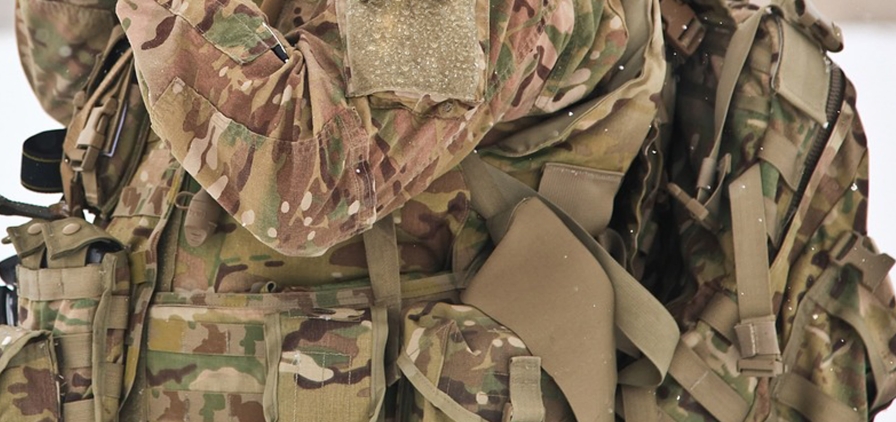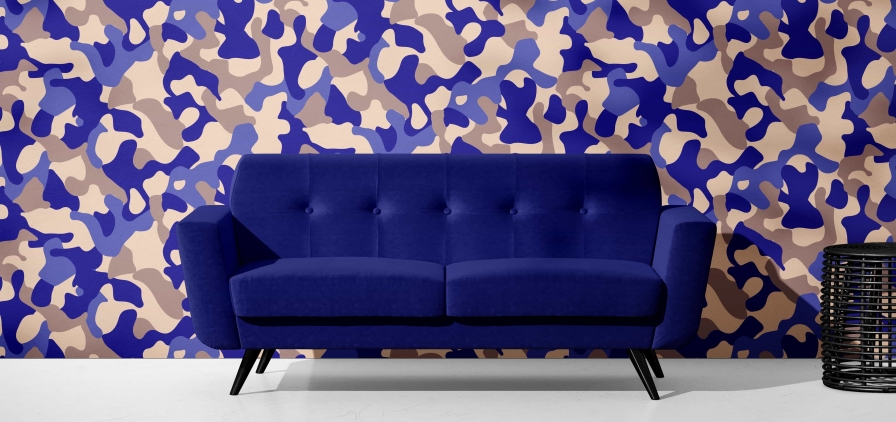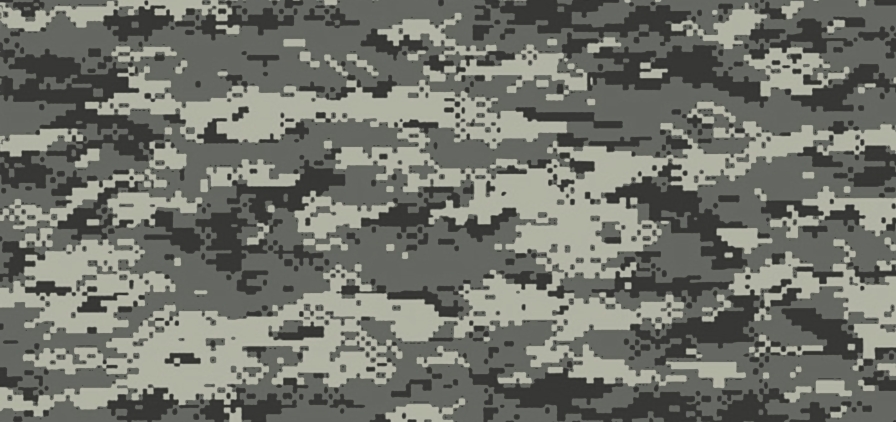
The Camouflage surface Pattern
A large part of the living world has mastered the art of camouflage, without even being aware of this talent for mimicry. Humans, on the other hand, do not have the ability to become naturally invisible. They are forced to resort to certain artifices such as the camouflage surface pattern to blend into a setting. Its primary function was to go completely unnoticed, but this is no longer its only option since it has become an essential surface pattern in fashion. Let's retrace the path that led "camo" from military strategy to textile design and decoration.
The camouflage surface pattern in military history
A seamless pattern invented during the "Great War" of 14-18
Cock-a-doodle-doo! The camouflage design was invented in France a little over a century ago. It also allowed many artists to work in the service of the nation during the First World War... The idea germinated in Lorraine in the fall of 1914, within a group of artists influenced by cubist painters. The camouflage surface pattern is a relevant field of application for these new pictorial techniques consisting of "decomposing" images by erasing their outlines. Inspired by his tamed chameleon, the decorative painter Louis Guingot created the textile pattern of the "leopard jacket", the first camouflage garment in history. He proposed the model to the French army, but his idea was not retained.
It was a second project, consisting of sheltering soldiers and artillery pieces under large painted canvases, which would allow camouflage to be integrated into the military world. The process was designed and tested by Guingot, accompanied by Eugène Corbin and Lucien-Victor Guirand de Scévola. Using his connections in Paris, Guirand de Scévola promoted the concept to the government. Its strategic potential convinced the military authorities to test the method in real conditions, on the Picardy front. A conclusive test: camouflage officially became a new military discipline.
Many artists signed up and joined the camouflage section, putting their talent and inventiveness at the service of France to create different camouflage processes that were indistinguishable in a given environment, or capable of "blurring" the enemy's visual perception. Camo patterns adorned large panels of fabric, but also tanks, planes and warships. In 1917, three French workshops produced kilometers of "green curtains" every day to meet the needs on the front.
The art of concealment at work in the army
The concept of "disruptive camouflage" continued to develop during the Second World War, carried by camouflagers no longer from the artistic world, but from the scientific world. Since then, the designs have continued to evolve and diversify to visually merge with all types of environments.
The undeniable effectiveness of war camouflage has led the armies of all nations to adopt these methods, relying on the latest technologies to optimize the textile patterns. There are therefore hundreds of standardized military camouflage textile patterns throughout the world, each the result of extensive research.
In 1973, the American Timothy O'Neil developed Dual-Tex, the first pixelated military camouflage pattern, which paved the way for particularly effective digital camouflage. But the camouflage outfit considered one of the most successful to date is called "ghillie". Equipped with fringes of fibers and synthetic materials, it allows soldiers to blend in completely with their environment to the point of becoming indistinguishable, even with binoculars equipped with night vision.

Camo, between world conflicts and the "Peace and Love" movement
From the end of the 1960s, against the backdrop of the Vietnam War, American peace activists adopted G.I. uniforms as a sign of protest. This counter-use transformed the camouflage pattern into an anti-militarist symbol, allowed it to gain popularity and opened the doors to fashion. From then on, it was worn as easily to support the war as to denounce its absurdity.
Although it is still used by the army, camo is today a playground for designers, who are particularly imaginative when it comes to diverting it for the benefit of fashion or decoration. Designers like to cultivate its ambiguity or offer unexpected variations, at the antipodes of its primary vocation. And if this graphic choice can sometimes correspond to an assumed bias in the collection of a committed designer, the civilian world clearly dissociates it from any political notion.
The camouflage seamless pattern for interior decoration
Unless you want to create a survivalist atmosphere, the camo pattern is rarely used in a total look and in the first degree in decoration. Diverted, reinterpreted, revisited, military camouflage no longer has much of a martial or disciplined aspect when it is invited indoors! It is most often integrated in the form of details, in small touches, in sober or bold color themes, or even explosive in a pop and offbeat spirit. Undulating waves, pixels, tachisme, foliage, the main thing is to keep the essence of the camouflage textile pattern, either by the graphic form or by the colors.
Declined in a cheerful and flashy palette, printed on bed linen, livening up a rug, a plaid or cushions, this is how a camouflage surface pattern finds its place best in a teenager's bedroom. In neutral or monochrome colours, camo wallpaper brings texture and a touch of pep to the walls of a living room, or is displayed as a print on curtains and net curtains. From a distance, nothing imitates nature better with discretion, but up close, its unexpected presence knows how to catch the eye without overdoing it!

The use of camouflage patterns in textile design
In textile design, inspiration can be drawn from everywhere, including at the source, that is to say in the repertoire of camo surface patterns used by the armed forces. Outside of their framework of use, these military designs are free from any constraints. This freedom allows creatives to completely reinvent them, by modifying the size of the seamless patterns, their shape or the colour combinations used to better match trends.
While waiting to discover the camouflages of the French Design by Textile Addict collection, let's take a quick look at the "veterans of military design", these official seamless patterns that we now come across in more peaceful contexts, printed on everyday fabrics and accessories.
"Lizard": This tiger textile pattern and its variants were used for over 30 years by the French army and adopted by around forty countries. Originally, its irregular "brushstrokes" stretched horizontally to break up the vertical lines of a human silhouette. It was mainly used in wooded environments or in the jungle, where its pale green, brown and olive green patches perfectly imitate dense vegetation, between shadow and light.
"Bariolage Centre Europe" or BCE: This major standard of the French army is most commonly used by soldiers operating in European forests. Dressed in beige, brown and black, this surface pattern is reminiscent of the texture of tree bark. Note that the Swiss army uses a very similar variation of this surface pattern, available in much more contrasting colors, but admirably well suited to autumn landscapes and carpets of dead leaves.
"Forest": The real name of this vintage textile pattern worn by American soldiers from 1981 to 2012 is "M81 Woodland". Designed to camouflage in forests and wooded environments, it is undoubtedly the best-known military camo print. Perfect for blending in with leaves, tree trunks and the ground, it is composed of irregular green, brown and black spots.
"Desert": More suited to dry and sandy areas, the one affectionately called "Chocolate chip camouflage" or more seriously "DBDU" (Desert Battle Dress Uniform) comes in fairly warm tones of beige, brown, red and ochre. It was intended for soldiers who had to operate in desert landscapes, where the dominant colors are those of sand and rock.
"Arid": Its code name is DCU (Desert Camouflage Uniform), but since its seamless patterns resemble coffee stains, it is nicknamed "coffee stain camouflage". Like the "Desert" camouflage, the Arid is intended for rocky environments and semi-desert areas. Its range of shades is a little wider and above all less contrasting, with shades of beige, light brown and gray, suitable for areas less uniform than deserts.
"Multicam": This camouflage composed of small and large superimposed spots is designed to be ultra-versatile. This chameleon print adapts to a wide range of environments: forests, desert expanses, urban areas... It mixes green, brown, beige and yellow tones, with the particularity of not only representing clear shapes, but also color fades.
"Pixel" or "Digital": Pixelated patterns are modern versions of camouflage that use dots and blocks of different sizes. They are designed to blur the lines of an individual's silhouette by modifying its contours, and are often used in urban or mixed environments. The best known is the "Marpat", designed to meet two very distinct objectives, to be both invisible and personalized. This recent print was of course developed to be one of the most discreet surface patterns at a distance, but also so that its wearer is immediately identifiable by adversaries up close.

"Raindrop" or Strichtarn: It is undoubtedly the most sober of all camouflage prints, and the easiest to integrate into a civilian outfit. Composed of a multitude of parallel broken lines of reddish brown color on a green-gray background, this pattern of German origin evokes stylized raindrops.
The “pile of leaves” or “Swedish camo M90”: Depending on its colors, this seamless pattern blends into temperate forests, tropical jungles, plains or deserts. Used since the 1970s for the camouflage of Swedish military vehicles, the M90 or FOA has the specificity of being composed of nested geometric shapes. This singularity makes it a somewhat unique camo, but very popular in textile design.
Summary table of the different camouflage patterns
|
Surface Pattern name |
Origin/Military Use |
Adapted environment |
Main Features |
|---|---|---|---|
|
Lizard |
Used by the French army for over 30 years, adopted by 40 countries. |
Wooded and jungle environments. |
Tiger pattern with irregular “brushstrokes”, pale green, brown and olive green hues. |
|
Central European (ECB) striping |
Standard of the French army, variant used by the Swiss army. |
European forests, autumn landscapes. |
Beige, brown and black shades reminiscent of bark, Swiss version with more contrasting colors. |
|
Forest (M81 Woodland) |
Worn by American soldiers from 1981 to 2012. |
Forests and wooded environments. |
Irregular green, brown and black spots imitating leaves and tree trunks. |
|
Desert (DBDU) |
Designed for desert and sandy areas. |
Deserts, dry areas. |
Beige, brown, red and ochre tones, sometimes nicknamed “Chocolate chip camouflage”. |
|
Arid (DCU) |
Developed for semi-desert and rocky areas. |
Rocky and semi-desert environments. |
Palette of beige, light brown and gray shades, spots reminiscent of “coffee stains”. |
|
Multicam |
Versatile camouflage, suitable for various environments. |
Forests, deserts, urban areas. |
A mix of green, brown, beige and yellow tones, combining clear shapes and color fades. |
|
Pixel (Digital) |
Modernization of camouflage, known for the "Marpat" seamless pattern |
Urban or mixed areas. |
Pixelated dots and blocks of various sizes, designed to blur outlines. |
|
Raindrop (Strichtarn) |
German origin, particularly sober. |
Easy to integrate into civilian outfits. |
Parallel broken lines in reddish brown on a green-gray background, reminiscent of stylized raindrops. |
|
Pile of leaves (Swedish camo M90) |
Developed for camouflage of Swedish military vehicles from the 1970s. |
Temperate forests, tropical jungles, plains, deserts (depending on colors). |
A textile pattern composed of nested geometric shapes, used in a variety of environments. |




















